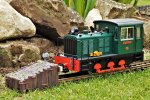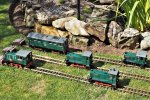David1226
Registered
This locomotive is based on the LGB 22620 DR Diesel Loco Ko 6503. Over the years this loco has been produced in many liveries and variants. This particular model was the German Railway version with all black bodywork and red underframe. This version is one that runs on an 0-6-0 chassis with outside fly cranks. It is European in appearance. The loco has also been produced with a long wheelbase 0-4-0 chassis, also with outside fly cranks, and US style footsteps, in various US liveries.
I have owned this model for many years, it has always been one of my favourites due to its size and heft and its outside fly cranks, which for me makes it an honorary steam loco. Due to its black German Railway livery and markings, I had always assumed that it was based on a European prototype.
It was not until I started to dismantle the loco, into its various component parts, preparatory to a repaint, that I realised that the loco is pure US in design. It sounds silly to admit it, after all this time, but I had never realised this before, probably due to its black livery masking some of the detail, but the cab, as well as having side doors, also has doors at the front, on either side, opening out onto the footplate, very much a US design feature. When I removed the cab roof, I was astounded to discover that the cab side windows are actually fitted with sun-visors that retract into the cab roof, again a design feature of US locomotives. I have seen many identical models running on various layouts, both indoors and outdoors, also, a good many more in photographs and videos, I have never seen one with the side window sun-visors folded out. I have to wonder, how many owners of this model are out there, who like me, are unaware of this feature on their loco.
With the cab roof off, the size and spaciousness of the cab can be seen to be very non-European. The driver figure is very American in appearance, with his ‘Engineer’s Hat’ and driver’s gauntlets.
Anyway, I am getting slightly ahead of myself, I will start with some photographs of the model in its original unmodified condition. The loco does have a factory fitted decoder, so no update was requires to the electrical bits.
The model before repainting.
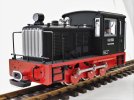
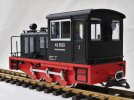
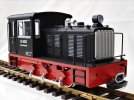
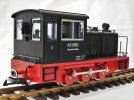
Very little was altered physically on this model. The cab side doors had moulded door handles which were carved off and replaced with handles filed from brass fret off-cuts. The front cab doors had locks without handles, so handles were added in the same way. The original brake pipes on the buffer beams were replaced with LGB Toy Train brake pipes, for continuity of appearance, as these are pretty much standard across all of the Claptowte Railway rolling stock. I could do little to alter the appearance of the driver figure, other than to carve off the gauntlet tops, on his forearms, to blend them in with the jacket sleeves. As with many of my previous conversions, the biggest change to the model’s appearance is brought about by a repaint.
For a corporate livery, for the diesel fleet, I chose a colour scheme of black underframes, green bodywork and, for the roofs, the same BR maroon coaching stock roof grey as used on the line’s passenger coaches. The green that I chose is PlastiKote RAL6005 satin Hunt Green. As with the steam locomotives, the buffer beams were finished in red. The cab interior is painted in BR cream.
When it came to reassembling the bonnet top fittings, I decided to swap the locations of some of the cowlings, and most noticeably the horn, to give what I consider to be a better appearance.
Once the painting had been completed, I applied etched brass name and number places, sourced from Custom Nameplate Studio.
The finished repainted model
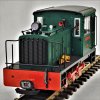
The repainted cab interior
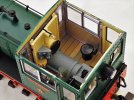
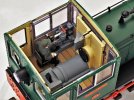
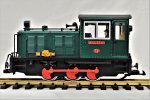
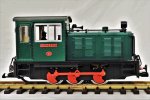
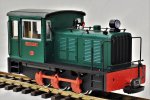
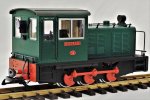
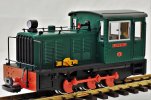
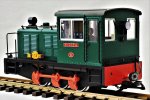
David
I have owned this model for many years, it has always been one of my favourites due to its size and heft and its outside fly cranks, which for me makes it an honorary steam loco. Due to its black German Railway livery and markings, I had always assumed that it was based on a European prototype.
It was not until I started to dismantle the loco, into its various component parts, preparatory to a repaint, that I realised that the loco is pure US in design. It sounds silly to admit it, after all this time, but I had never realised this before, probably due to its black livery masking some of the detail, but the cab, as well as having side doors, also has doors at the front, on either side, opening out onto the footplate, very much a US design feature. When I removed the cab roof, I was astounded to discover that the cab side windows are actually fitted with sun-visors that retract into the cab roof, again a design feature of US locomotives. I have seen many identical models running on various layouts, both indoors and outdoors, also, a good many more in photographs and videos, I have never seen one with the side window sun-visors folded out. I have to wonder, how many owners of this model are out there, who like me, are unaware of this feature on their loco.
With the cab roof off, the size and spaciousness of the cab can be seen to be very non-European. The driver figure is very American in appearance, with his ‘Engineer’s Hat’ and driver’s gauntlets.
Anyway, I am getting slightly ahead of myself, I will start with some photographs of the model in its original unmodified condition. The loco does have a factory fitted decoder, so no update was requires to the electrical bits.
The model before repainting.




Very little was altered physically on this model. The cab side doors had moulded door handles which were carved off and replaced with handles filed from brass fret off-cuts. The front cab doors had locks without handles, so handles were added in the same way. The original brake pipes on the buffer beams were replaced with LGB Toy Train brake pipes, for continuity of appearance, as these are pretty much standard across all of the Claptowte Railway rolling stock. I could do little to alter the appearance of the driver figure, other than to carve off the gauntlet tops, on his forearms, to blend them in with the jacket sleeves. As with many of my previous conversions, the biggest change to the model’s appearance is brought about by a repaint.
For a corporate livery, for the diesel fleet, I chose a colour scheme of black underframes, green bodywork and, for the roofs, the same BR maroon coaching stock roof grey as used on the line’s passenger coaches. The green that I chose is PlastiKote RAL6005 satin Hunt Green. As with the steam locomotives, the buffer beams were finished in red. The cab interior is painted in BR cream.
When it came to reassembling the bonnet top fittings, I decided to swap the locations of some of the cowlings, and most noticeably the horn, to give what I consider to be a better appearance.
Once the painting had been completed, I applied etched brass name and number places, sourced from Custom Nameplate Studio.
The finished repainted model

The repainted cab interior








David

